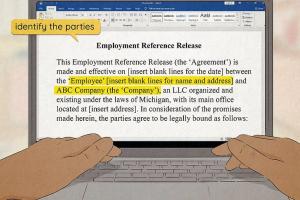Mastering the Art of Negative References: How to Give a Negative Employee Reference Thoughtfully

-
Quick Links:
- Introduction
- Understanding the Need for Negative References
- Legal Considerations
- Preparing for the Reference Call
- How to Communicate Negative Feedback
- Case Studies and Examples
- Expert Insights
- Conclusion
- FAQs
Introduction
Giving a negative employee reference can be one of the most challenging tasks for an employer or HR professional. It requires a delicate balance of honesty and professionalism. This article will guide you through the process of providing a negative reference while minimizing potential risks and ensuring ethical standards.
Understanding the Need for Negative References
References play a critical role in the hiring process. They provide insight into a candidate's previous performance and behavior. When an employee has exhibited problematic behavior or poor performance, future employers deserve to know the potential risks involved. However, the way this information is communicated can greatly impact both the former employee's reputation and the referring party's integrity.
Legal Considerations
Before providing a negative reference, it’s essential to understand the legal implications. Here are a few key points to consider:
- Defamation: Ensure that your comments are factual and not based on personal opinions or hearsay.
- Privacy: Respect the former employee's privacy and confidentiality. Only share information that is relevant to their job performance.
- Company Policy: Familiarize yourself with your company's policies regarding references. Some companies have strict guidelines on what can be disclosed.
Preparing for the Reference Call
Preparation is key when giving a negative reference. Here are steps to follow:
- Review Documentation: Gather performance reviews, disciplinary actions, and any relevant documentation that supports your claims.
- Plan Your Message: Create a concise message that highlights key issues without embellishing the facts.
- Practice: Consider role-playing the reference call with a trusted colleague to refine your delivery.
How to Communicate Negative Feedback
When delivering negative feedback, remember to:
- Be Honest: Provide clear examples of issues you encountered without being overly harsh.
- Stay Professional: Maintain a neutral tone and avoid personal attacks.
- Offer Context: Help the new employer understand the circumstances that led to the issues.
Case Studies and Examples
Real-world examples can illustrate effective ways to handle negative references. Here are a few case studies:
Case Study 1: The Insubordinate Employee
A manager had an employee who consistently disregarded company policies. When contacted for a reference, the manager explained the employee’s lack of compliance while emphasizing that the individual had strengths in creativity. This approach allowed the new employer to make an informed decision without solely focusing on the negatives.
Case Study 2: The Underperforming Sales Rep
Another case involved a sales representative who failed to meet targets. The reference provider highlighted the employee’s inability to follow through on tasks while also noting their positive attitude and teamwork effort. This balanced perspective provided a more comprehensive view of the candidate.
Expert Insights
To further enhance your understanding, we spoke with HR professionals who specialize in reference checks. Here are their insights:
"It's crucial to strike a balance between honesty and diplomacy. A negative reference doesn't have to be a death sentence for the candidate, but it should provide enough context for the new employer to understand any potential challenges." - Jane Doe, HR Consultant.
Conclusion
Giving a negative employee reference is never easy, but with the right approach, it can be done ethically and professionally. By preparing adequately, communicating clearly, and providing context, you can help future employers make informed decisions without compromising your integrity or the former employee's dignity.
FAQs
1. Can I refuse to give a reference?
Yes, if you're uncomfortable providing a reference, you can decline. However, it's best to do so politely and professionally.
2. What if I only have negative things to say?
Focus on being factual and provide specific examples to support your claims without being overly harsh.
3. How can I protect myself legally while giving a negative reference?
Stick to facts, avoid personal opinions, and familiarize yourself with your company’s reference policy.
4. Should I provide a negative reference in writing or verbally?
It often depends on the request; however, verbal references allow for more nuanced communication.
5. How can I frame a negative reference positively?
Highlight any strengths the candidate may have had while being honest about their weaknesses.
6. Is it ethical to give a negative reference?
Yes, it is ethical as long as you provide honest, factual information that could help the new employer.
7. What if my organization has a policy against giving negative references?
In such cases, you may need to provide a neutral reference or confirm employment dates only.
8. How do I handle follow-up questions about a negative reference?
Be prepared to provide additional context and examples if asked, maintaining professionalism.
9. Can I give a reference for a former employee who wasn’t a good fit?
Yes, but ensure to balance your feedback with constructive criticism.
10. What if the candidate sues me for a negative reference?
As long as your comments are truthful and based on documented evidence, you are typically protected from defamation claims.